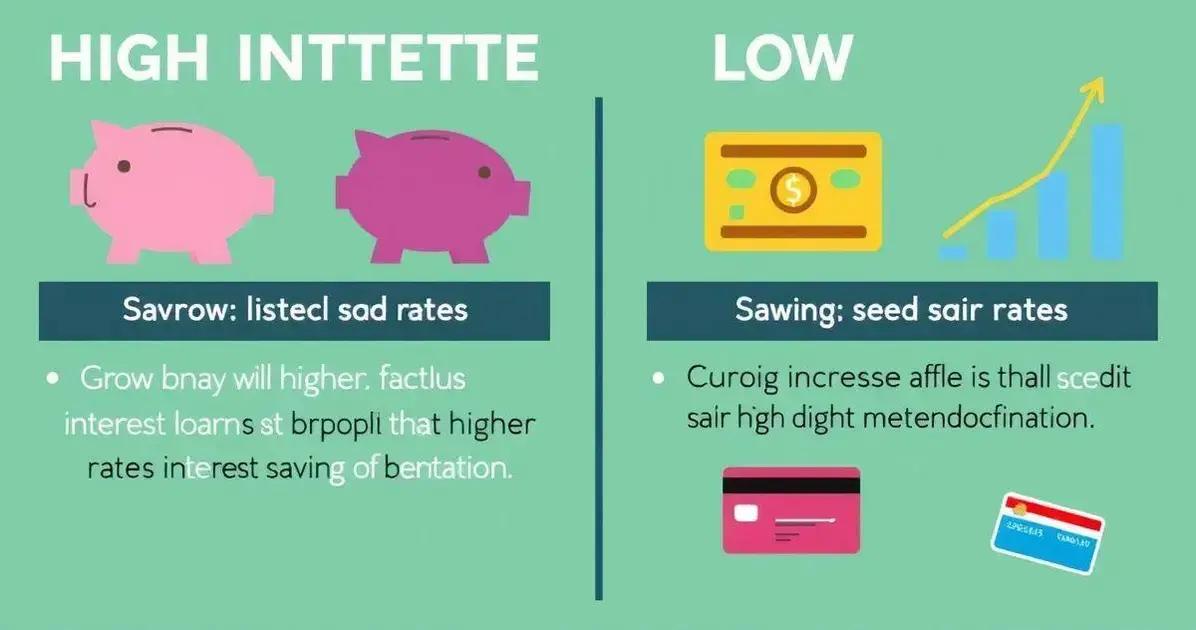Interest Rates Explained: How They Impact Your Financial Future
Advertiser
Interest rates are vital in financial planning, directly impacting savings growth and loan costs. Set by central banks, these rates control inflation and guide economic stability. Monitoring their trends helps anticipate economic changes, ensuring informed decision-making for individuals and businesses alike.
In today’s ever-changing economic landscape, understanding **Interest Rates** is pivotal in shaping your financial decisions. Whether you’re saving for the future or planning to take a loan, these rates play a crucial role in determining your financial outcomes. This article will cover the essentials from understanding the **basics of interest rates** to how they directly impact your savings and loans.
Understanding the Basics of Interest Rates
Interest rates are fundamental to the financial world, influencing everything from personal loans to national economies. They represent the cost of borrowing money, usually expressed as a percentage. This percentage is added to the principal amount, allowing lenders to earn a profit. It’s essential to grasp this concept to make informed financial decisions.
Types of Interest Rates
Interest rates come in different forms. Fixed interest rates remain constant throughout the loan term, making budgeting predictable. In contrast, variable rates fluctuate based on market conditions. Understanding the type you’re dealing with is crucial for managing financial expectations.
Calculating Interest Rates
The calculation of interest can be simple or compound. Simple interest is calculated on the principal amount only, while compound interest includes accumulated interest. Knowing the difference helps in evaluating financial products, such as savings accounts or loans.
The Impact of Inflation
Inflation is a key factor that affects interest rates. Generally, when inflation rises, interest rates increase to maintain purchasing power. This relationship highlights the importance of monitoring economic indicators when dealing with interest-bearing financial tools.
Moreover, credit scores heavily influence the interest rate one might receive. A higher credit score can secure a lower rate, potentially saving significant amounts over time. Hence, maintaining good credit is advantageous.
How Interest Rates Affect Your Savings and Loans

Interest rates play a pivotal role in shaping both your **savings** and **loan** scenarios. When it comes to savings accounts, higher interest rates mean more earnings on your deposited money. This can significantly boost your savings over time, allowing your funds to grow faster.
Savings Accounts
Banks often offer interest on savings accounts based on prevailing rate trends. A rise in rates usually means better returns for savers. However, during periods of lower rates, the compounding effect diminishes, affecting the pace at which savings grow.
Impact on Loans
In the context of loans, interest rates determine how much you will pay back over the principal. Higher rates increase the overall cost of borrowing, which can impact your budget planning and financial health. This applies to everything from mortgages to personal loans.
On the other hand, if interest rates drop, refinancing options may become attractive, leading to lower monthly payments and reduced interest expenses. Staying informed of rate changes helps in making strategic financial decisions.
Credit Card Debt
Handling credit card debt is also influenced by interest rates. Higher rates can lead to rapidly accumulating balances if not managed carefully. Paying off outstanding amounts during periods of low rates can prevent interest from building up significantly.
The Role of Central Banks in Setting Interest Rates
Central banks are key players in the financial ecosystem, with the power to influence interest rates profoundly. These institutions, like the Federal Reserve in the United States, are responsible for setting the benchmark interest rates, which ripple through the economy.
Monetary Policy
Through monetary policy, central banks aim to control inflation and stabilize the currency. By adjusting interest rates, they can either stimulate economic growth or cool off inflationary pressures. This balance is crucial for maintaining economic stability.
When a central bank lowers interest rates, borrowing becomes cheaper, encouraging spending and investment. Conversely, raising rates tends to slow down economic activity, as loans become more expensive, reducing consumer and business spending.
Inflation Targeting
Inflation targeting is a primary tool used by central banks. By keeping inflation within a target range, central banks strive to maintain the purchasing power of the currency. This is often achieved by altering the interest rate to either encourage or discourage economic activity, depending on inflationary trends.
Market expectations are also swayed by central bank communications. Announcements and policy statements can lead to immediate financial market reactions, affecting everything from stock prices to currency valuations.
Predicting Future Trends in Interest Rates

Predicting the future of interest rates is a challenge that requires understanding several economic indicators. Analysts monitor economic growth, inflation rates, and employment figures to forecast how these rates might shift. Economic growth often correlates with changes in interest rates, as strong growth can lead to increased rates to curb potential inflation.
Inflation forecasts play a crucial role in these predictions. If inflation is expected to rise, central banks may increase interest rates to maintain price stability. Conversely, low inflation expectations could lead to rate cuts to boost economic activity.
Global Influences
Global economic events also impact interest rate trends. Changes in international trade policies, geopolitical tensions, and foreign market health can all influence domestic rate decisions. Keeping an eye on these factors can provide signs of where rates might head.
Additionally, advancements in technology and changes in consumer behavior impact the economic landscape, influencing rate predictions. Analysts also consider historical trends to identify potential patterns that may reoccur.
Understanding and Navigating Interest Rates for Financial Success
Interest rates influence many facets of economic and personal financial health. By grasping the basics, individuals can make informed decisions about savings and borrowing. Awareness of how central banks set rates and forecast future changes is essential in anticipating market shifts.
From boosting savings yields to affecting loan affordability, rates are vital in financial planning. Monitoring trends and understanding influencing factors like inflation provide a clear picture of potential economic movements.
As global and domestic variables continue to shape the interest rate environment, staying informed empowers both individuals and businesses to strategize effectively amid economic uncertainties. Embrace the knowledge of interest rates to secure a stable and prosperous financial future.
FAQ – Understanding Interest Rates and Their Impact
How do interest rates affect my savings?
Higher interest rates increase the earnings on your savings, allowing your funds to grow faster over time.
What impact do interest rates have on loans?
Interest rates determine the cost of borrowing; higher rates mean higher loan costs, affecting your financial planning.
Why do central banks change interest rates?
Central banks adjust rates to control inflation, stabilize the currency, and manage economic growth.
How can I predict future interest rate trends?
Monitoring economic indicators like growth, inflation, and global events can help predict interest rate changes.
What is the difference between fixed and variable interest rates?
Fixed rates remain constant over the loan term, while variable rates fluctuate based on market conditions.
How does my credit score affect the interest rate I receive?
A higher credit score can secure lower interest rates, saving you money over the life of a loan.






